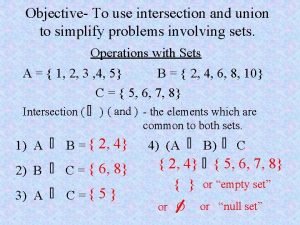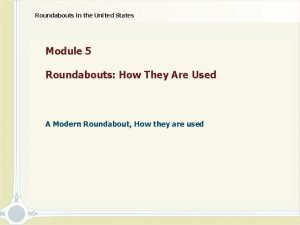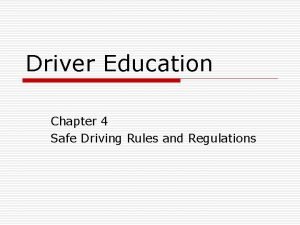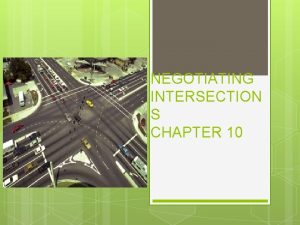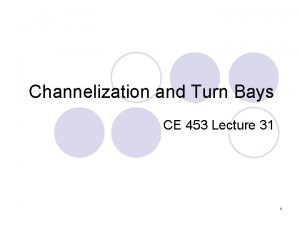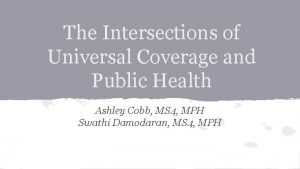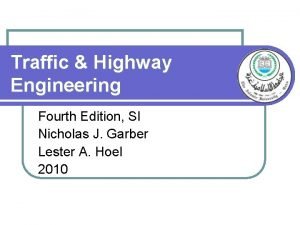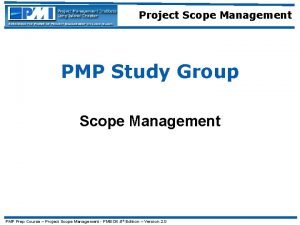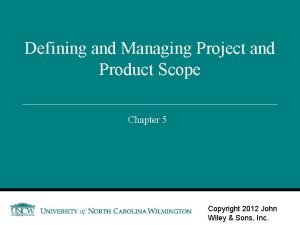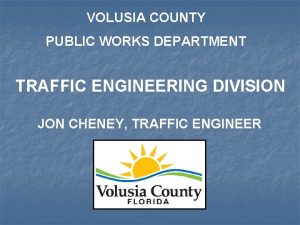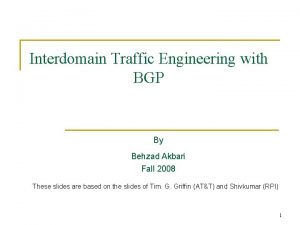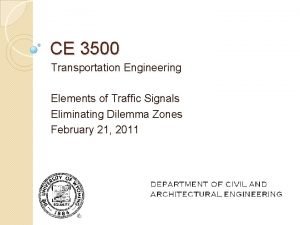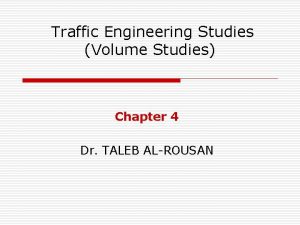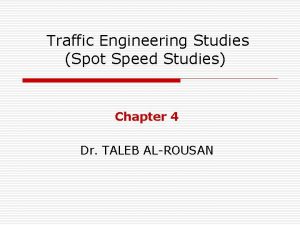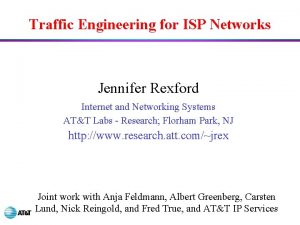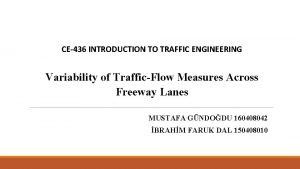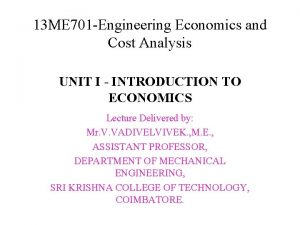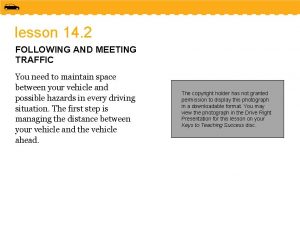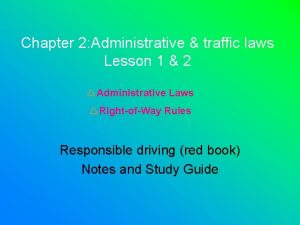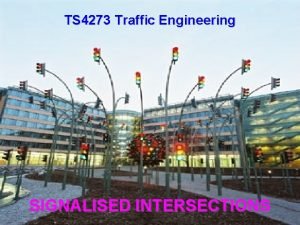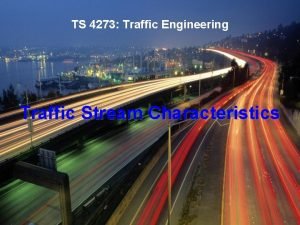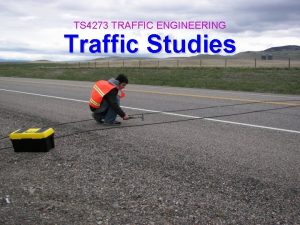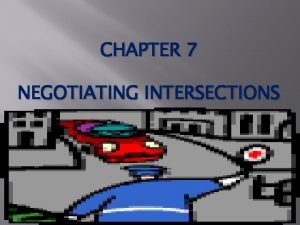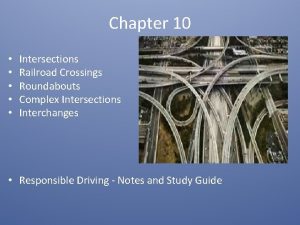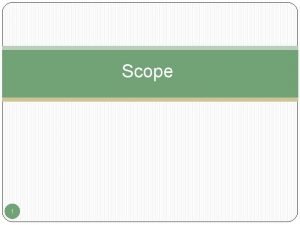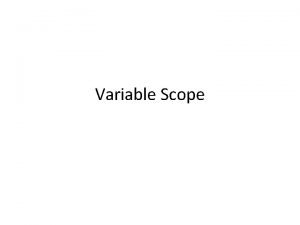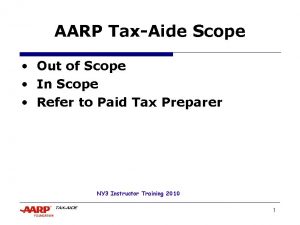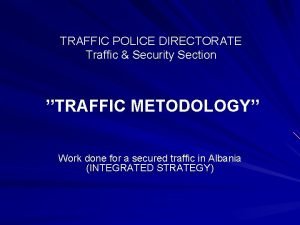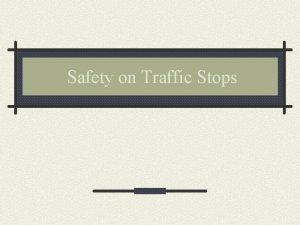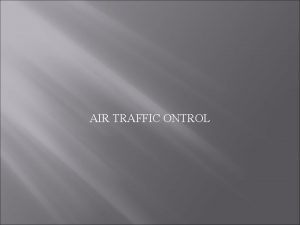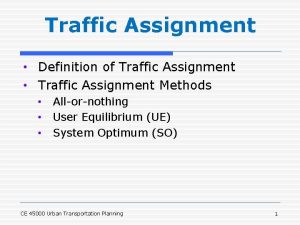TS 4273 Traffic Engineering UNSIGNALISED INTERSECTIONS Scope and













![City Size Classes CS [Table A-3: 1 p. 3 -29] City Size Inhab. (M) City Size Classes CS [Table A-3: 1 p. 3 -29] City Size Inhab. (M)](https://slidetodoc.com/presentation_image/0aedf22e09daf282e40a43185ee7ede2/image-14.jpg)
![Road Environment Type RE [Table A-3: 2 p. 3 -29] Commercial Residential Restricted Access Road Environment Type RE [Table A-3: 2 p. 3 -29] Commercial Residential Restricted Access](https://slidetodoc.com/presentation_image/0aedf22e09daf282e40a43185ee7ede2/image-15.jpg)



























- Slides: 42

TS 4273 Traffic Engineering UNSIGNALISED INTERSECTIONS

Scope and Objectives This chapter deals with 3 -arm and 4 -arm unsignalised intersections which are formally controlled by the basic Indonesian traffic code rule give-way to the left. This method assumes right angled intersections in flat alignment and is valid for degree of saturation less than 0, 8 -0, 9.

Traffic Safety Considerations • Effect of intersection layout – 3 -arm with T-shape 40% lower accident rates than 4 -arm. – Y-shape have 15 -50% higher accident rates than T-shape. • Effect of geometric design – Median (3 -4 m) on major road reduces the accident rates (if the road wider than 10 m)

Traffic Safety Considerations • Effect of intersection control – Yield sign control reduces the accident rates 60% compare to priority from the left – Stop sign control reduces the accident rates 40% as compared to yield sign. – Traffic signal control reduces the accident rates 20 -50% compared to uncontrolled operation.

Performance Measures of Unsignalised Intersections • • Capacity (C) Degree of saturation (DS) Delay Queue probability

Range of Variation in Empirical Data for Input Variables (4 -Arm) Variable Approach width (m) Left-turn ratio Right-turn ratio Minor road flow ratio Light vehicle-% Heavy vehicle-% Motorcycle-% Unmotorised flow ratio Min. 3, 5 0, 10 0, 00 0, 27 29 1 19 0, 01 Avg. 5, 4 0, 17 0, 13 0, 38 56 3 33 0, 08 Max. 9, 1 0, 29 0, 26 0, 50 75 7 67 0, 22

Range of Variation in Empirical Data for Input Variables (3 -Arm) Variable Approach width (m) Left-turn ratio Right-turn ratio Minor road flow ratio Light vehicle-% Heavy vehicle-% Motorcycle-% Unmotorised flow ratio Min. 3, 5 0, 06 0, 09 0, 15 34 1 15 0, 01 Avg. 4, 9 0, 26 0, 29 56 5 32 0, 07 Max. 7, 0 0, 51 0, 41 78 10 54 0, 25

Definition of Unsignalised Intersection Types in IHCM (4 -Arm) Type Code 422 424 M 444 M Minor road Major road approaches No. of lanes Median No. of lanes 1 N 1 2 Y 1 2 N 2 2 Y 2

Definition of Unsignalised Intersection Types in IHCM (3 -Arm) Type Code 322 324 M 344 M Minor road Major road approaches No. of lanes Median No. of lanes 1 N 1 2 Y 1 2 N 2 2 Y 2

STEP A-1: Geometric Conditions • • Date Handle by City and province Major and minor road names Case Period Sketch of intersection geometry and dimension

STEP A-2: Traffic Condition • • • Sketch of turning movement flow Traffic composition pcu-factor K-factor pce-values

STEP A-2: Traffic Condition

STEP A-3: Environmental Condition • City Size (p. 3 -29 Table A-3: 1 or p. 3 -34 Table B-5: 1) • Road Environment (p. 3 -29 Table A-3: 2 or p. 3 -35 Table B-6: 1) • Side Friction (p. 3 -29 Table A-3: 2 or p. 3 -35 Table B-6: 1)
![City Size Classes CS Table A3 1 p 3 29 City Size Inhab M City Size Classes CS [Table A-3: 1 p. 3 -29] City Size Inhab. (M)](https://slidetodoc.com/presentation_image/0aedf22e09daf282e40a43185ee7ede2/image-14.jpg)
City Size Classes CS [Table A-3: 1 p. 3 -29] City Size Inhab. (M) Very Small 0, 1 Small > 0, 1 - 0, 5 Medium > 0, 5 - 1, 0 Large > 1, 0 - 3, 0 Very Large > 3, 0
![Road Environment Type RE Table A3 2 p 3 29 Commercial Residential Restricted Access Road Environment Type RE [Table A-3: 2 p. 3 -29] Commercial Residential Restricted Access](https://slidetodoc.com/presentation_image/0aedf22e09daf282e40a43185ee7ede2/image-15.jpg)
Road Environment Type RE [Table A-3: 2 p. 3 -29] Commercial Residential Restricted Access Commercial land use (e. g. shops, restaurants, offices) with direct roadside access for pedestrians and vehicles Residential land use with direct roadside access for pedestrians and vehicles No or limited direct roadside access (e. g. due to the existence of physical barriers, frontage streets etc).

Side Friction class SF • Side friction describes the impact of road side activities in the intersection area on the traffic discharge, e. g. pedestrians walking on or crossing the carriageway, angkot and buses stopping to pick up or let off passengers, vehicle entering and leaving premises and parking lots outside the carriageway. • Side friction is defined qualitatively from traffic engineering judgment as high, medium or low.

STEP B-1: Approach Width and Intersection Type

STEP B-1: Approach Width and Intersection Type Average intersection approach width, WI: WI = (a/2+b+c/2+d/2)/4 If A is only exit: WI = (b+c/2+d/2)/3 Road entry widths: WAC = (a/2+c/2)/2 WBD = (b+d/2)/2

STEP B-1: Approach Width and Intersection Type Average road approach width WAC, WBD (m) WBD = (b+d/2)/2 < 5, 5 No. of lanes (total for both directions) 2 WAC = (a/2+c/2)/2 5, 5 No. of lanes (total for both directions) 4

STEP B-1: Approach Width and Intersection Type Average road approach widths WAC, WBD and Average intersection approach width WI. • WAC = (WA+WC)/2 and WBD = (WB+WD)/2 • WI = (WA+WC+WB+WD)/no. intersection arms.

STEP B-1: Approach Width and Intersection Type IT Code No. of intersection minor road arms lanes No. of major road lanes 322 3 2 2 324 3 2 4 342 3 4 2 422 4 2 2 424 4 2 4

STEP B-2: Base Capacity Value C 0 Intersection Type Base Capacity C 0 (pcu/h) 322 2. 700 342 2. 900 324 or 344 3. 200 422 2. 900 424 or 444 3. 400

STEP B-3: Approach Width Adjustment Factor FW • 422 FW = 0, 70 + 0, 0866 WI • 424 or 444 FW = 0, 61 + 0, 0740 WI • 322 FW = 0, 73 + 0, 0760 WI • 324 or 344 FW = 0, 62 + 0, 0646 WI • 342 FW = 0, 67 + 0, 0698 WI

STEP B-3: Approach Width Adjustment Factor FW • 422 FW = 0, 70 + 0, 0866 WI • 424 or 444 FW = 0, 61 + 0, 0740 WI • 322 FW = 0, 73 + 0, 0760 WI • 324 or 344 FW = 0, 62 + 0, 0646 WI • 342 FW = 0, 67 + 0, 0698 WI

STEP B-4: Major Road Median Adjustment Factor FM Description Type M Median adjustment factor, FM No major road median. None 1, 00 Major road median exists, width < 3 m Narrow 1, 05 Major road median exists, width 3 m Wide 1, 20

STEP B-5: City Size Adjustment Factor FCS City Size Inhab. (M) FCS Very Small 0, 1 0, 82 Small > 0, 1 - 0, 5 0, 88 Medium > 0, 5 - 1, 0 0, 94 Large > 1, 0 - 3, 0 1, 00 Very Large > 3, 0 1, 05

STEP B-6: Road Environment, Side Friction & Unmotorised AF FRSU

STEP B-7: Left-Turning Adjustment Factor FLT

STEP B-8: Right-Turning Adjustment Factor FRT • 4 -arm • 3 -arm

STEP B-9: Minor Road Flow Ratio Adjustment Factor FMI 422 (p. MI 0, 1 -0, 9) • FMI=1, 19 p. MI 2 -1, 19 p. MI+1, 19 424 (p. MI 0, 1 -0, 3) • FMI=16, 6 p. MI 4 -33, 3 p. MI 3+25, 3 p. MI 2 -8, 6 p. MI+1, 95 444 (p. MI 0, 3 -0, 9) • FMI=1, 11 p. MI 2 -1, 11 p. MI+1, 11

STEP B-9: Minor Road Flow Ratio Adjustment Factor FMI 322 (p. MI 0, 1 -0, 5) • FMI=1, 19 p. MI 2 -1, 19 p. MI+1, 19 322 (p. MI 0, 5 -0, 9) • FMI=-0, 595 p. MI 2+0, 595 p. MI+0, 74 342 (p. MI 0, 1 -0, 5) • FMI=1, 19 p. MI 2 -1, 19 p. MI+1, 19 342 (p. MI 0, 5 -0, 9) • FMI=2, 38 p. MI 2 -2, 38 p. MI+1, 49

STEP B-9: Minor Road Flow Ratio Adjustment Factor FMI 324 (p. MI 0, 1 -0, 3) • FMI=16, 6 p. MI 4 -33, 3 p. MI 3+25, 3 p. MI 2 -8, 6 p. MI+1, 95 344 (p. MI 0, 3 -0, 5) • FMI=1, 11 p. MI 2 -1, 11 p. MI+1, 11 344 (p. MI 0, 5 -0, 9) • FMI=-0, 555 p. MI 2+0, 555 p. MI+0, 69

STEP B-10: Actual Capacity C

STEP C-1: Degree of Saturation DS

STEP C-2: Delays D (Intersection Traffic Delay DTI) DS 0, 60 • DTI = 2 + 8, 2078 DS - (1 -DS)2 DS > 0, 60 • DTI = [1, 0504/(0, 2742 -0, 2042 DS)] - (1 -DS)2

STEP C-2: Delays D (Major Road Traffic Delay DTMA) DS 0, 60 • DTMA = 1, 8 + 5, 8234 DS - (1 -DS) 1, 8 DS > 0, 60 • DTMA = [1, 05034/(0, 346 -0, 246 DS)] - (1 -DS) 1, 8

STEP C-2: Delays D (Minor Road Traffic Delay DTMI) • DTMI = (QTOTAL x DTI – QMA x DTMA) / QMI

STEP C-2: Delays D (Intersection Geometric Delay DG) • DS < 1, 00 • DG = (1 -DS) x (p. Tx 6 + (1 -p. T)x 3) + 4 x. DS • DS 1, 00 • DG = 4

STEP C-2: Delays D (Intersection Delay D) • D = DG + DTI

STEP C-3: Queue Probability

STEP C-4: Evaluation of Traffic Performance • If the obtain DS values are too high (> 0, 75), we should revise our assumptions regarding approach width etc and make a new set of calculations.

Perbaikan Simpang Tak Bersinyal di Indonesia • Perbaikan geometri (sudut & radius tikungan) • Manajemen lalulintas (rambu & marka) • Pengaturan PKL (represif & preventif) • Pulau lalulintas (lebar jalan > 10 m) • Lebar median di jalan utama (min 3 -4 m)
 Transportation engineering
Transportation engineering Module 5 topic 1
Module 5 topic 1 Intersection vs union
Intersection vs union Module 5 intersections and roundabouts
Module 5 intersections and roundabouts Controlled uncontrolled and blind intersections
Controlled uncontrolled and blind intersections Incomina
Incomina Intelligent traffic solutions
Intelligent traffic solutions Negotiating intersections chapter 10
Negotiating intersections chapter 10 An uncontrolled railroad crossing usually has a
An uncontrolled railroad crossing usually has a Uncontrolled railroad crossings usually have ______.
Uncontrolled railroad crossings usually have ______. T-intersections
T-intersections An uncontrolled railroad crossing usually has a
An uncontrolled railroad crossing usually has a Chapter 7 negotiating intersections
Chapter 7 negotiating intersections Traffic and highway engineering 4th edition
Traffic and highway engineering 4th edition Process scope definition
Process scope definition Io2br3
Io2br3 Volusia county traffic engineering
Volusia county traffic engineering Multi leg intersection
Multi leg intersection Bgp inbound traffic engineering
Bgp inbound traffic engineering Parking accumulation curve
Parking accumulation curve Elements of traffic engineering
Elements of traffic engineering Traffic engineering studies
Traffic engineering studies Which is the best method for spot speed analysis
Which is the best method for spot speed analysis Traffic engineering
Traffic engineering Introduction to traffic engineering
Introduction to traffic engineering Elements of traffic engineering
Elements of traffic engineering Traffic engineering network
Traffic engineering network Discuss the nature of educational psychology
Discuss the nature of educational psychology Roles of engineering drawing
Roles of engineering drawing Scope of engineering economics
Scope of engineering economics Scope of engineering economics
Scope of engineering economics Costica uwitonze
Costica uwitonze Engineering ethics in practice a guide for engineers
Engineering ethics in practice a guide for engineers Forward engineering in software engineering
Forward engineering in software engineering Computer based system engineering in software engineering
Computer based system engineering in software engineering Principles of complex systems for systems engineering
Principles of complex systems for systems engineering Engineering elegant systems: theory of systems engineering
Engineering elegant systems: theory of systems engineering Reverse engineering vs forward engineering
Reverse engineering vs forward engineering Sign sign everywhere a sign
Sign sign everywhere a sign Meeting traffic
Meeting traffic Traffic throttling and load shedding
Traffic throttling and load shedding Self checking testbench
Self checking testbench Administrative vs traffic laws
Administrative vs traffic laws


